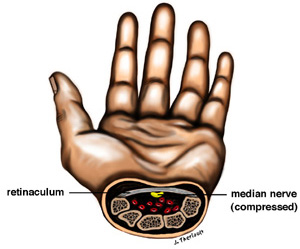Carpal Tunnel Syndrome
Sometimes people may experience numbness or tingling in the hand, especially at night, and clumsiness handling objects such as glasses or cups. There also tends to be pain that goes up the entire arm, in some cases all the way to the shoulder. These symptoms may be due to a condition called Carpal Tunnel Syndrome.
What is it?

Prognosis
If left untreated, gradual impairment of the nerve function can occur to the point where permanent damage can be sustained if left too long. This can result in hand weakness to the point where objects can no longer be grasped firmly, and fine detail work is impossible. If the underlying cause of the carpal tunnel is an acute incident, like a hard blow to the hand, it usually subsides with simple treatments. Commonly, however, Carpal Tunnel Syndrome has to be surgically released, especially if it has built up over a period of time and is of unknown cause.
Some underlying causes of carpal tunnel are pregnancy, rheumatoid arthritis, inflammatory conditions, and repetitive trauma to the hand such as heavy manual labor. Quite often, however, no underlying cause is found.
Diagnosis
The diagnosis is often made from the following symptoms and signs :
-
Numbness and tingling in the hands
-
Decreased feeling in your thumb, index, and long finger
-
An electric-shock-like feeling in your hand when the doctor taps over the course of the median nerve at the wrist
-
Reproduction of symptoms when holding wrists in a bent down position for one minute.
In some cases, the doctor may want a special test performed called a nerve conduction study, which will determine the severity of the pressure on the median nerve and finalize the diagnosis.
Treatment
Non-Surgical
A brace or splint may be applied to mild cases which is usually worn at night to keep the wrist from bending. Resting the wrist allows the swollen and inflamed synovial membranes to shrink, which takes some of the pressure off of the nerve. Also, the use of anti-inflammatory medications can take away some of the inflammation and swelling. In more severe cases, the treatment may entail the use of a cortisone injection into the carpal tunnel. The injection spreads medicine around the swollen synovial membranes and shrinks them, again relieving the pressure on the nerve. The usual dosage of cortisone is small and has no harmful side effects. Non-surgical treatment is effective if the issue is diagnosed early, and thus treated soon after onset.
Other non-surgical methods of treatment include putting up with the problem, changing jobs, anti-inflammatory medication, physiotherapy, rest, etc.
Surgical
In some patients, non-surgical treatment doesn’t relieve the pain and symptoms, so the next step is to operate. The operation is called a “release” because the ligament that forms the roof of the carpal tunnel is cut to relieve the pressure on the median nerve. The operation is performed under a local anesthetic that is injected into the wrist, hand, or arm. The ligament that forms the roof of the carpal tunnel is called the volar carpal ligament. This ligament has to be released through a small incision which relieves the pressure on the median nerve and allows it to recover. This is performed as a same-day surgery and can quite often be performed involving the patient going to sleep. Occasionally, it does require general anesthetic, but this can usually be avoided. The release can now also be performed arthroscopically, so that a smaller incision and a shorter recovery period can be obtained.
Most of the time the surgery is performed in an outpatient facility and overnight stay at the hospital isn’t required.
Outcome of Surgery
The long-term surgical results are usually excellent. It must be remembered, however, that the length of time for the nerve to recover depends on how long the nerve has been compressed. If extensive damage has been done to the nerve through a long period of pressure over several months, it may take as many months for the nerve to fully regain its function. During this period of time, the hand will gradually get stronger and sensation will return to the hand. If there has been no underlying permanent damage to the nerve, full-function should return to the hand. Occasionally, there is such severe damage to the nerve that there may be only partial, or no improvement.
Risks to Surgery
There are risks to any surgical procedure, including: infection, damage to nerves, persistent symptoms, anesthetic problems, etc. Make sure you understand the risks and alternatives prior to surgery.
Prognosis
As stated previously, early recognition and treatment are crucial, but treatment is still key in situations that take longer to diagnose. If left untreated, gradual impairment of the nerve function can occur to the point where damage become permanent. This can result in hand weakness to the point where objects can no longer be grasped firmly, and fine-detailed work will be impossible.
Prevention
In order to prevent Carpal Tunnel Syndrome, one must know the etiology. Since there isn’t a specific cause for Carpal Tunnel Syndrome, there really isn’t a good way to prevent it. What we do know, is that anything that causes swelling, thickening, or irritation of the synovial membranes around the tendons in the carpal tunnel can result in pressure on the median nerve.
Some associated conditions are the following:
-
Grasping with the hands forcefully and repetitively
-
Constant bending of the wrist
-
Broken or dislocated bones in the wrist which produce swelling
-
Arthritis
-
Sugar diabetes
-
Thyroid gland imbalance
-
Menopause (hormonal changes)
-
Pregnancy
